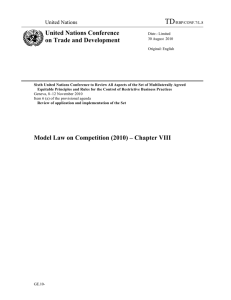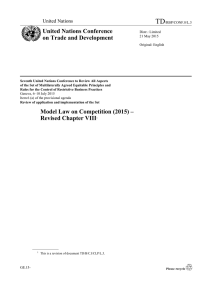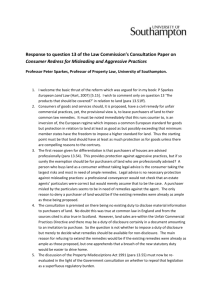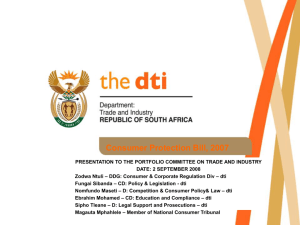TD United Nations Conference on Trade and Development United Nations
advertisement
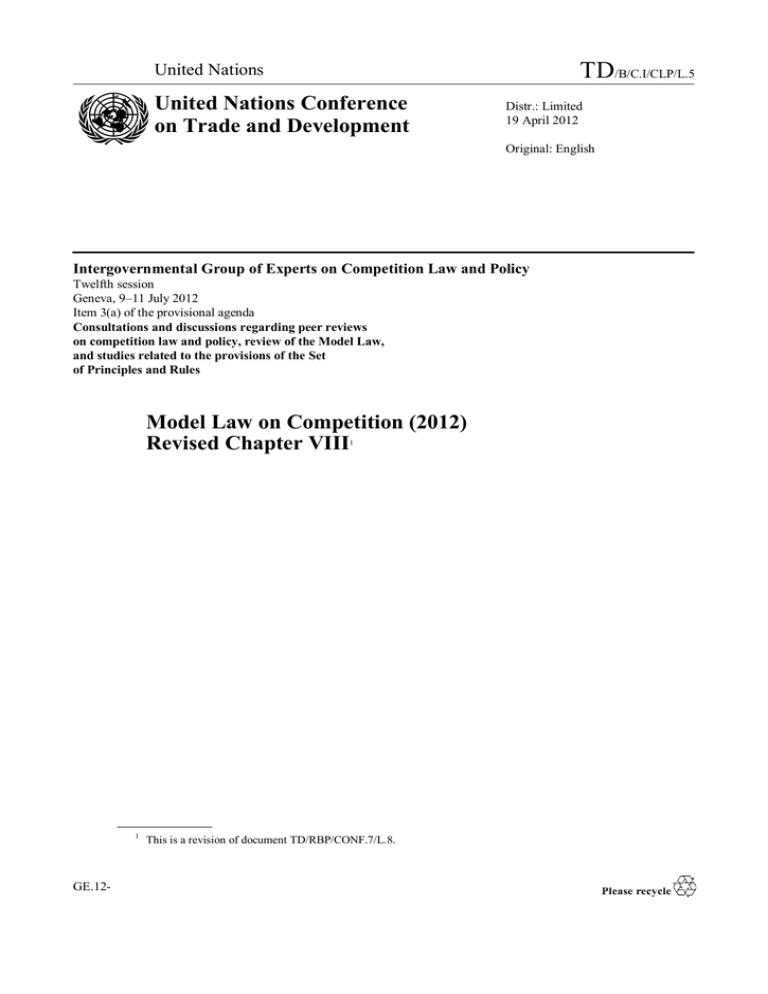
TD/B/C.I/CLP/L.5 United Nations United Nations Conference on Trade and Development Distr.: Limited 19 April 2012 Original: English Intergovernmental Group of Experts on Competition Law and Policy Twelfth session Geneva, 9–11 July 2012 Item 3(a) of the provisional agenda Consultations and discussions regarding peer reviews on competition law and policy, review of the Model Law, and studies related to the provisions of the Set of Principles and Rules Model Law on Competition (2012) Revised Chapter VIII 1 1 GE.12- This is a revision of document TD/RBP/CONF.7/L.8. TD/B/C.I/CLP/L.5 Some possible aspects of consumer protection “In a number of countries, consumer protection legislation is separate from restrictive business practices legislation.” Commentaries on Chapter VIII and alternative approaches in existing legislation Introduction 1. Both consumer protection and competition policies promote consumer welfare. The two policies address this goal from a different perspective, they are often mutually reinforcing yet there are important differences in how the two policies are executed. 2. Before dealing with the relationship between consumer protection and competition laws and policies, which is addressed by Chapter VIII of the Model Law on Competition, it appears useful to provide some basic information on consumer protection. Rationale for and contents of consumer protection legislation 3. Consumer protection legislation is based on the finding that consumers often face imbalances in economic terms, educational levels and bargaining power, compared to the companies they deal with. Therefore, the typical consumer protection law seeks to prevent consumer welfare losses originated by this weaker position. The ways to achieve this objective differ significantly between different countries. Indeed, it can be stated that consumer protection legislation is much more diverse than competition laws. According to the United Nations Guidelines for Consumer Protection,2 which provide some guidance for the design of consumer protection legislation, it is recommended that such legislation addresses the following aspects: “(a) (b) The protection of consumers from hazards to their health and safety; The promotion and protection of the economic interests of consumers; (c) Access of consumers to adequate information to enable them to make informed choices according to individual wishes and needs; (d) Consumer education, including education on the environmental, social and economic impacts of consumer choice; (e) Availability of effective consumer redress; (f) Freedom to form consumer and other relevant groups or organizations and the opportunity of such organizations to present their views in decision-making processes affecting them; (g) 2 2 The promotion of sustainable consumption patterns.” United Nations Guidelines for Consumer Protection (as expanded in 1999), available at: http://www.un.org/esa/sustdev/publications/consumption_en.pdf. TD/B/C.I/CLP/L.5 4. Below, we provide some examples of how these different aspects can be translated into consumer protection legislation. Product safety regulation 5. Product safety continues to be one of the key issues in consumer protection legislation. Product safety regulation has grown out of consumers’ increasing expectations about the quality and safety of the products that are supplied to them. These expectations may be enhanced by the increasing use of the internet as a mechanism to quickly and easily research product and ingredient safety. For this reason, it is particularly important that consumers have faith in the protection provided by their national product safety system. National safety regulations are usually complemented by national or international standards and the maintenance of safety records to ensure that products are safe for intended or normally foreseeable use. In some countries such as Australia, product safety powers have recently been extended to also cover reasonably foreseeable misuse of products. Australia may be quoted as an example of a country with a well-designed compliance and enforcement system for product safety regulations. Since 2010, the Australian Competition and Consumer Commission (ACCC) has enjoyed a range of new powers to promote product safety, including enforcing a mandatory reporting requirement which requires suppliers to lodge a report within 48 hours of becoming aware of a serious injury, illness or death associated with a product they supply. This reporting obligation also applies to suppliers of services associated with the consumer product. Product safety powers also include the ability to order a mandatory recall (including when the supplier no longer exists), issue a Safety Warning Notice to alert the public to possible hazards, and seize, embargo or otherwise contain non-compliant or unsafe goods. These powers complement the ACCC’s expanded range of penalties which can apply when non-compliance with mandatory requirements is detected.3 Protection from false or misleading information 6. Generally, the traditional purview of consumer protection legislation is the prevention of unfair trade practices. In this regard, there is much legislation preventing businesses or trade associations from disseminating false or misleading information about a product, whether on the label of the product or via a marketing campaign. For example, the Barbados Consumer Protection Act broadly states that “a person shall not, in trade or commerce as a supplier, engage in conduct that is, or is likely to be, misleading or deceptive.” The legislation goes on to list a number of situations that could be deemed “misleading” or “deceptive”, for example, falsely representing that goods are of a particular standard; falsely representing that goods have a certain performance characteristic; misleading representations about the existence of conditions, warranties, rights or remedies in relation to a good or service.4 Control of standard contract terms 7. In some industries, businesses use standard form contracts with mandatory terms included that essentially compel a customer to accept the terms; the freedom of the consumer to contract and exercise his or her choice is therefore limited. Some countries have adopted regulations, for specified sectors, that dictate the compliance of business with standardized/model contracts. Other jurisdictions provide for a specific procedure in order for those standard contract terms to be incorporated into a consumer contract, and allow for 3 4 For more information on how the reforms were introduced, see: http://www.productsafety.gov.au/content/index.phtml/tag/ChangesInLegislation. Barbados Fair Competition Act 2002-19, CAP.326C, Sections 12 and 13. 3 TD/B/C.I/CLP/L.5 in-depth control of the respective terms by a judge. For instance, in line with the European Union’s Unfair Contract Terms Directive, 5 the German Civil Code requires that, prior to concluding a consumer contract, the consumer be made aware of the incorporation of standard terms into the contract, and that he or she be given the possibility to read the relevant standard terms. Furthermore, standard contract terms in consumer contracts can be examined by a judge and declared void if they are unfair.6 This control of contract terms constitutes a limitation on freedom of contract. Information disclosure requirements 8. Given the need of consumers to have access to sufficient information in order to make an informed choice about the products and services they would like to purchase, and taking into account the imbalance of information between consumers and producers/distributors, it may be appropriate to mandate information disclosure by the latter. For example, a rule can be designed to ensure that specified, critical information is available to consumers, allowing consumers to make more informed decisions about which product or service to purchase. One example of a very common disclosure requirement is compulsory labelling of products. Food, in particular, often needs to be labelled in a very detailed way, providing information that is crucial for consumers’ health. 9. If rules are focused on information availability, rules or systems must also be created so that the consumer can process the complex information that is available to him or her. In designing rules, it should be remembered that information is not always key, as information overload can simply promote confusion and inertia. To complement an information disclosure rule, lawmakers can design functional systems which help consumers to process the information, and which can also be used for getting tips and tools to consumers. 10. For example, the European Union’s (EU’s) Consumer Scoreboard is a system which investigates and monitors markets from the perspective of the consumer. An Annual Consumer Scoreboard Report is prepared, which provides information on price, complaints, safety, satisfaction and switching in consumer retail markets. Data and attitudes of consumers vis-à-vis cross-border trade with a view to tracking progress in retail market integration are catalogued; data are also catalogued on enforcement, redress, and the handling of complaints, with the aim of establishing consumer conditions at the EU level and the Member State level. The data are collected using EU-wide surveys and are then processed and analysed. The data from the scoreboard are expected to help in the enforcement of existing legislation and in the design of targeted codes of conduct for businesses, and will also be used to empower consumers with clear and manageable information, to make choices, avoid fraud and exercise their rights.7 Mandatory codes of conduct or rules of behaviour 11. In addition to mandating certain rules of behaviour, there appears to be a growing trend towards encouraging businesses to self-regulate, subject to the approval of the consumer protection agency. 12. For instance, the United Kingdom’s Office of Fair Trading (OFT) Consumer Codes Approval Scheme (CCAS) grants its approval to groups of businesses, via their trade association, that voluntarily undertake a code of conduct that promotes or protects 5 6 7 4 Council Directive 93/13/EEC of 5 April 1993 on unfair terms in consumer contracts, O.J. 1993 L95/29. See sections 305 to 310 of the German Civil Code (Bürgerliches Gesetzbuch). Communication from the European Commission, “Monitoring consumer outcomes in the single market: the Consumer Markets Scoreboard”, 29 January 2008, COM(2008) 31 final. TD/B/C.I/CLP/L.5 consumer interests, and which meets with the criteria set by the OFT to govern the scheme. Effectively, trade associations draft self-regulatory rules aimed at addressing specific consumer concerns, such as the need for pre-contractual information disclosure, truthful advertising and labelling, and fair contractual terms and conditions. The code is submitted to the OFT, and in order to secure the OFT’s “seal” of approval, certain core criteria must be met; for example, membership must include a majority of the firms in a sector; observation and compliance with the code must be mandated for all members; code sponsors should have access to adequate funding and resources to accomplish the objectives of the code, and they must also be able to demonstrate that organizations representing consumers, as well as enforcement bodies, were consulted throughout the preparation of the code.8 13. In Japan, the Premiums and Representations Act also provides for self-regulation. Its Article 11 states that “[an] entrepreneur or a trade association may, upon obtaining authorization from the Fair Trade Commission and the Prime Minister pursuant to the Cabinet Office Ordinance, with respect to the matters relevant to premiums or representations, conclude or establish an agreement or a rule, aiming at prevention of unjust inducement of customers and securing fair competition and independent and rational choice by general consumers. The same shall apply in the event alterations thereof are attempted.”9 Functioning of competition and consumer protection legislation 14. As mentioned earlier, both competition and consumer protection legislation act to promote consumer welfare, yet they do so in different ways. Competition law promotes competitive behaviours (rivalry, independent behaviour, incentives to develop better offers of goods ands services) leading to a range of choices/options in services and goods available to the consumer, whereas consumer protection law reinforces consumers’ access and freedom to select among the available choices/options according to their preferences and interests. Competition legislation should benefit consumers, but it is often not so direct in this regard; it uses a set of rules, in a general and uniform manner, to bring about benefit to the market as a whole. Instead, consumer protection laws use targeted rules, addressed at specific sectors sometimes, to create a more empowered and advantaged consumer. Finally, whereas competition law normally deals with specific situations that have a significant effect on the competitive process of a market, consumer protection law deals with effects on both individuals and the collective of consumers, but it is not always concerned with the process of competition in the market. 15. Competition law rules are squarely directed at the market and are designed around regulating the way firms compete with each other in a market, with a view to promoting competition among firms and thereby enhancing consumer choice. Consumer protection law has a more diverse range of rules, which addresses the conduct of firms and the standards by which they operate, and the rules of engagement between individual businesses and consumers, with a view to promoting access to goods and services, promoting greater quality in the choice available, and ensuring consumer access to reliable and undistorted information to assist the consumer in making that choice. Whereas the benefit of competition law is usually quantified in economic terms, the benefit of consumer protection law can be economic, and it can also engender non-economic quantities of value such as the safety and health of the consumer. The subjects of the rules are therefore sometimes different. 8 9 Office of Fair Trading “Consumer Codes Approval Scheme. Core Criteria and Guidance”, OFT 390, March 2008. Act Against Unjustifiable Premiums and Misleading Representations, Law No.134 of 1962. 5 TD/B/C.I/CLP/L.5 16. As a matter of general application of the law, competition laws have an applicable limit in the sense that competition rules of exclusionary conduct and collusion cannot be manipulated to bring about change in a particular sector or in the structure of a particular market. The rules are generally applied uniformly across the board. Consumer protection laws, on the other hand, can be used to impose rules of behaviour on firms in a particular sector to give consumers better information on choice, access to safer goods, and redress in the case of misleading contract terms. In addition, consumer protection law is rights protection at the level of the individual transaction, providing rights protection against a range of abuses; whereas competition law occurs at the level of the marketplace, carrying out its agenda by promoting consumer interests not at the transactional level but at the level of the competitive process in the relevant market. 17. With respect to the design of remedies, it is important to note that consumer protection law remedies can be far more targeted than competition law remedies; the remedies of consumer protection law, like the prescribed rules, can go beyond fines and prohibition of conduct. A wider array of tools can therefore be employed in this regard. For example, restitution via compensatory damages is one option; so too are prevention and deterrence via fines, punishment via imprisonment, and suspension of business licences. As regards restitution in particular, since consumer protection law is usually grounded in principles of fairness and balance of rights, restitution will be one of the more effective remedial tools. For example, restitution allows remedies to develop in a less rigid manner, allowing for the particular facts of the case to dictate an equitable outcome for both the firm and the consumer. As a general guide to remedy design, it should be noted that one key element in determining the choice of remedy in consumer protection law appears to be that the magnitude of the sanction must outweigh the opportunistic infringing conduct.10 18. However, one area’s remedies can sometimes have implications in the other domain. For instance, consumer legislation usually includes the development of standards to protect consumer interests. Yet, if standards are set too high, they could exclude safe but lowerquality competing products. 19. While acknowledging the different modes of functioning of consumer protection and competition laws, it should be remembered that competition issues are closely related to protection of consumers’ economic interests. For instance, Canada has acknowledged how the policies enhance each other: “The reference to consumers in the purpose clause of the Competition Act reflects Parliament’s appreciation that a properly functioning marketplace requires not only enforcement against market power abuses, but also transparency in information provided to consumers to promote well-informed purchasing decisions. Hence, consumer and competition policy are mutually reinforcing […]”11 The interface between consumer protection and competition law12 20. The coverage of consumer protection laws differs. The United Nations Guidelines do not define a “consumer.” While consumer protection laws generally cover natural 10 11 12 6 Cseres K (2009). Competition and consumer policies: Starting points for better convergence. Amsterdam Centre for Law and Economics working paper no. 2009-06. 1 April. Available at: http://ssrn.com/abstract=1379322. OECD Global Forum on Competition (2008). The interface between competition and consumer policies. DAF/COMP/GF(2008)10. 5 June. For a comprehensive overview, see Unctad Secretariat (2012) “Consumer Protection and Competition Policy” background note for the First Ad-hoc Expert Meeting on Consumption Protection, to be held on July 12 and 13, 2012. TD/B/C.I/CLP/L.5 persons in their household setting, some laws extend coverage to natural persons in their roles as sole proprietors or subsistence farmers.13 It is argued that the concerns related to health, safety, economic interests, asymmetric information, cognitive biases and access to redress are similar in these settings to those in the household setting. 21. Policy tools partially overlap: both policies use market studies, advocacy, guidelines and law enforcement. Indeed, authorities including the UK’s OFT have found that market studies/sector enquires are extremely useful as a dual competition-consumer tool. Consumer investigations are apparently more numerous but less resource-intensive. This has been recognised, by a number of authorities, as an opportunity to fully develop team skills along more frequent cases in the area of consumer protection, which can later be applied in the area of competition. Consumer authorities also partner with consumer organizations to deliver information and advice to consumers14 and provide consumer redress. 22. Responsibility for competition and consumer protection policies may lie with separate or a common agency; it may also be either general or sector specific. e.g., a telecommunications regulator may also be responsible for competition and consumer protection policies in that sector as is the case in Zambia. Also, financial regulators in many countries have been given the main role in the protection of consumers in this sector. The respective agencies can cooperate through sharing or referring complaints or information. When a complaint is received, it may be unclear whether the concern is better addressed through a competition or consumer protection framework, raising coordination challenges. In addition, consumer organizations may report not just consumer but also competition problems. Forwarding complaints and sharing the results of investigations, where appropriate, between agencies responsible can make it easier to apply the most suitable policy framework. Greater institutional cooperation between competition and consumer policy authorities may engender better coordination of investigations and remedies. 23. Given the common goals of consumer protection and competition policy and law, and taking into account their significantly different ways of functioning, the question arises of how to design their interface, both on the legislative and the enforcement level. Legislative level 24. Chapter VIII of the Model Law on Competition states that in a number of countries, consumer protection legislation is separate from competition legislation. In fact, the present trend in countries adopting such legislation seems to be the enactment of two separate laws – one on competition and the other on consumer protection. For example, in young competition regimes, such as those of Barbados, Jamaica and Mongolia, and at the Community level in CARICOM, competition law and consumer protection law are dealt with under separate legislation. The same applies to Brazil, Chile, Morocco and Switzerland, among others. In some countries and regions, however, such as Australia, France, Hungary and Poland, and in CARICOM’s regional law, the competition law contains a chapter devoted to consumer protection. This is also the case, for example, in Lithuania and in the Bolivarian Republic of Venezuela, where the competition laws contain 13 14 India, Consumer Protection Act of 1986, Section 2(1)(d) provides the same protection to purchases of goods and services bought for earning a livelihood as for personal or household consumption. Other examples such as China and the Philippines in UNCTAD Secretariat (2010), “Approaches to Consumer Redress,” manuscript. A concern is the appropriateness of the media used to deliver consumer education to the target group: Elderly, illiterate or minority language inhabitants may need different approaches than urban, internet-savvy youth. 7 TD/B/C.I/CLP/L.5 regulations on “unfair trade practices”. In Canada, the Competition Act contains provisions dealing with misleading advertising and deceptive marketing practices. These provisions are designed to ensure that consumers are provided with basic, uniform and accurate information on certain consumer products, and to proscribe deceptive and false representations. Enforcement level 25 The approach reflected by the Model Law on Competition — that of drafting two separate laws — does not prevent a coordinated approach to policy development, and although consumer protection legislation may be developed separately from competition legislation, the laws can be enforced in a coordinated way, which allows the policies to complement and enhance one another. Also, because of the links between the two bodies of law, the administration of these laws is often the responsibility of the same authority. This is the case, for example, in Algeria, Australia, Colombia, Costa Rica, Finland, France, Mongolia, New Zealand, Panama, Peru, Poland, the Russian Federation, Sri Lanka, the United Kingdom and the United States, and in Hungary and Italy15 at least to a certain extent. 26. In other jurisdictions, the administration of competition and consumer protection laws is attributed to different authorities. For instance, in Chile and Estonia, consumer protection legislation and the Consumer Protection Authority are separate from competition legislation and the Competition Authority. In the case of Estonia, the Competition Act also contains provisions on unfair trade practices, which contraventions are determined by a civil court. Other countries follow a partial separation of duties, with implications to institutional coordination. This is the case in Zambia, where consumer protection legislation is covered under section 12 of the Competition Law. However, it does not deal with specific matters of consumer welfare, such as public health, standards, sales, and hire purchase. Therefore, in administering consumer protection, the Competition Commission works closely with other bodies such as local authorities, the Bureau of Standards, and the public health service. 27. The trend in institutional design seems to be to house the consumer protection agency with the competition authority. 16 Indeed, there appear to be far more countries housing their competition authorities with their consumer protection agencies – even though a separate department is created for each agency in most instances, for example Australia, Barbados, Canada, France, Jamaica, Malta, Mongolia, Papua New Guinea, Poland, the Republic of Korea, and the United States, to name a few. Designing a competition authority of dual competence — competition law enforcement and consumer protection — could create synergies if there is effective coordination. For example, dual competence of an agency gives rise to centralized management, operational efficiencies, case teams with a range and diversity of disciplines, and the efficient use of available expertise. Of course, there are disadvantages, too, for while the two areas of law are similar, 15 16 8 In order to protect the interests of consumers and to foster fair market practices, the Hungarian Parliament, in 2008, implemented the Unfair Commercial Practices Directive 2005/29, which was incorporated into Hungarian law by Act XLVII of 2008 on the Prohibition of Unfair Business-toConsumer Commercial Practices. In accordance with the provisions of the Act, there are three different authorities that are responsible for consumer protection: the Hungarian Competition Authority (GVH), the Hungarian Financial Supervisory Authority (PSZÁF), and the Hungarian Consumer Protection Authority (NFH). Despites this trend, the UK is currently considering merging the OFT and the Competition Commission into one single competition authority, while housing consumer protection (currently at the OFT) at Local Authority Trading Standards services. TD/B/C.I/CLP/L.5 it is sometimes difficult to coordinate the procedures for a law that applies at the individual consumer level with those for a law that applies at the market level; and it is sometimes difficult to coordinate the laws at the case level. 17 Despite the trend towards dual competence, there is nothing to prevent lawmakers from housing the agencies separately. It should also be noted that even in cases where there are separate agencies, it is possible to coordinate the activities of both agencies either for specific areas or common cases, or through the establishment of an oversight committee or a central commission, which seats representatives from the competition authority and from the consumer protection agency, as well as individuals from other government departments and ministries.18 17 18 OECD Global Forum on Competition (2008). The interface between competition and consumer policies. DAF/COMP/GF(2008)10. 5 June. Ibid. 9
